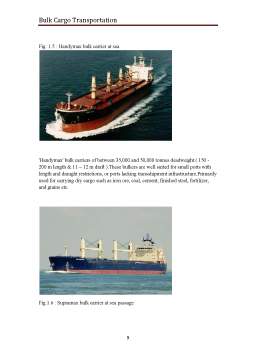Extras din proiect
CAP I BULK CARRIERS. GENERAL ARRANGEMENT.SIZES.
A general arrangement of a typical bulk carrier shows a clear deck with machinery aft. Large hatches with steel covers are designed to facilitate rapid loading and discharge of the cargo. Since the bulk carrier makes many voyages in ballast a large ballast capacity is provided to give adequate immersion of the propeller.
The general-purpose bulk carrier, in which usually the central hold section only is used for cargo. The partitioned tanks which surround it are used for ballast purposes either on ballast voyages, or in the case of the saddle tanks, to raise the ship's center of gravity when a low density cargo is carried. Some of the double-bottom tanks may be used for fuel oil and fresh water.
Fig. 1.1 :Profile of a typical bulk carrier
The saddle tanks also serve to shape the upper region of the cargo hold and trim the cargo. Large hatchways are a feature of bulk carriers, since they reduce cargo-handling time during loading and unloading.
Fig. 1.2 : A Bulk carrier on sea passage
Bulk carrier general arrangement and size range are similar to that of tankers, as shown in Figure . Single-purpose bulk carriers are generally designed as ore carriers, built to carry heavy cargoes stowing at 25 cubic feet per long ton or less, or dry bulk carriers, for grain and similar cargoes stowing at 45 to 50 cubic feet per ton.
Like tankers, the general arrangement of cargo spaces is dictated by the facts that the cargo is in the form of homogeneous particles of more or less uniform size, and can be transferred by blowers, conveyors, or grab buckets. Cargo spaces are divided into holds to meet structural and subdivision requirements, to restrain cargo movements and resulting upsetting moments, to permit the carrying of different cargoes simultaneously, and to provide for ballasting. Machinery is invariably aft, and the nonperishable nature of the cargoes leads to speeds in the 12- to 16-knot range, with attendant full hull forms.
Relatively small volumes of dense ores and similar cargoes will settle a ship to her summer load line. Holds on ore carriers are therefore quite small, bounded by broad wing tanks and deep double bottoms. The double bottom and longitudinal bulkheads are of heavy construction to carry the heavy ore load.
The narrow hold breadth limits transverse weight shifts and the depth of the double bottom is sufficient to keep the center of gravity of the ore high enough to prevent stiff rolling in a seaway. Large volume wing tanks are used for ballast.
Fig. 1.3: Bulk carrier
Fig. 1.4 : Cargo hold construction of a typical bulk carrier
Designed for low-density cargoes, dry bulk carriers require much greater hold volume than ore carriers, and therefore have much shallower inner bottoms .
In some designs the topside tanks are omitted or fitted with bolted plates in the sloping plating facing the hold. When very light cargoes are carried, the plates are removed and the tanks are filled along with the hold; the cargo in the tanks feeds into the hold by gravity when discharging. Larger carriers are sometimes built with an inner side shell, which eases hold cleaning and provides additional ballast space.
Preview document
Conținut arhivă zip
- Bulk Cargo Transportation.docx












































